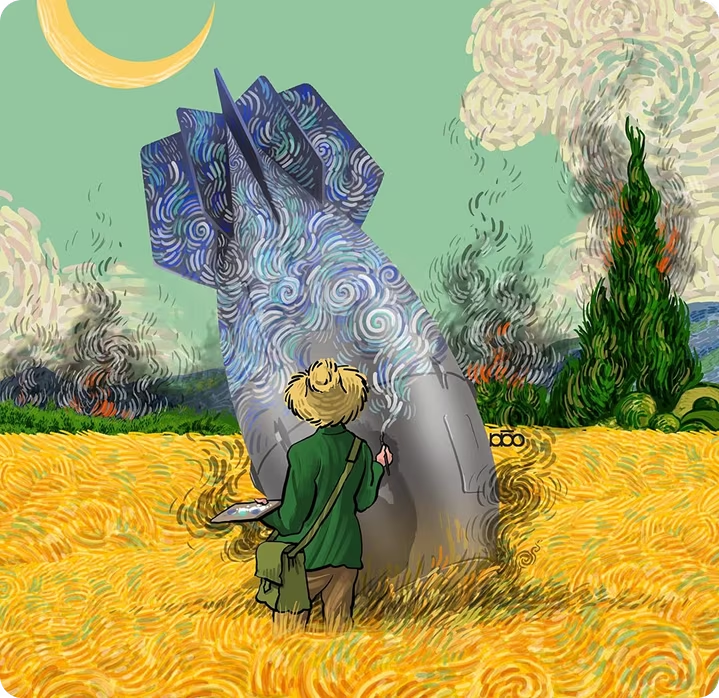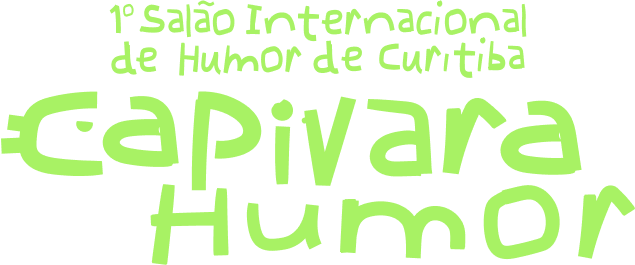Curitiba smiles again with wit, sensitivity, and sharp strokes.
The 1st International Humor Salon of Curitiba revives he tradition of major humor salons across Brazil and the world, restoring to the “smiling city” a space to laugh deeply, think lightly, and provoke with empathy.
More than just an artistic event, this salon is an invitation: a call for cartoonists, editorial artists, caricaturists, and graphic artists from around the globe to express themselves freely and consciously on social, philosophical, and health-related issues.
Laugh with ethics, think with courage
This salon is not about easy jokes. It seeks sharp, intelligent, and compassionate perspectives on what it means to be human in all its complexity.
Humor can be as swift as a razor and as warm as an embrace. It can mock and enlighten. It can criticize and heal.
That’s why we invite you, artist of the line, to dive into this theme with boldness, ethics, and freedom.
Draw what few dare to say. Give form to the invisible. Laugh at the absurd — but never at the pain.
Because when used well, humor doesn’t close wounds. It opens dialogues.
Main Theme
Bipolar Disorder: between euphoria and darkness
The choice of theme is not random. It’s necessary. In times when mental health is one of society’s most pressing issues, humor can be a powerful tool for demystifying, welcoming, and reflecting.
Bipolar disorder is an invisible challenge for many and profoundly real for those who live with it. It is characterized by intense swings between two emotional poles: euphoria and depression.
These shifts go far beyond “normal mood swings.” They deeply impact daily life, relationships, and the inner world of those living with the condition.
Bipolar Depression
At one end of this emotional rollercoaster is bipolar depression: deep, silent, and paralyzing. It’s not just simple “sadness.” It’s an existential exhaustion that affects the body, mind, and will to live.
During this phase, the person may isolate, lose interest in activities they once enjoyed, feel worthless or guilty, and lack the energy even for basic tasks. Concentration is impaired, appetite and sleep patterns change, and negative — often self-destructive — thoughts can arise.
And the worst part: this pain often goes unnoticed by those on the outside.
Bipolar Euphoria
The euphoric episode — clinically known as manic or hypomanic — may initially appear positive. The person seems to be “on top,” full of ideas, energy, charisma, and enthusiasm. But behind this vibrant appearance is an imbalance that can be exhausting and even dangerous.
During this phase, the person talks excessively, thinks too quickly, sleeps little (or not at all), and feels a constant urgency to take on several projects at once. They become impulsive, spend without thinking, take unnecessary risks, engage in reckless behavior, and sometimes act disconnected from reality.
It may resemble “uncontrolled creativity,” but it’s often a state of invisible suffering.
Humor with Responsibility
Humor is a powerful tool. It can hurt, but it can also heal. It can ridicule, but it can also humanize.
This salon invites artists to use their linework, irony, and creativity to shed light on the bipolar experience, demystify mental suffering, and help end the stigma surrounding mental health.
Bipolar Disorder in the Lives of Public Figures
Throughout history, many public figures and brilliant artists have left a deep mark on the world while dealing with intense emotional challenges. Among them are Vincent van Gogh, Jackson Pollock, Edgar Allan Poe, Mariah Carey, Ben Stiller, Kurt Cobain, and Buzz Aldrin. While not all were formally diagnosed in life, there are reports, studies, and biographies suggesting that these individuals lived experiences compatible with bipolar disorder.
This condition, marked by fluctuations between extreme euphoria and deep depression, seems to have intertwined with their creative, philosophical, and even scientific journeys. Van Gogh painted compulsively during his emotional highs and later plunged into total isolation. Poe turned his anguish into dark and lyrical prose. Kurt Cobain channeled his instability into raw and poetic compositions. Mariah Carey, who has been diagnosed, spoke publicly about her struggle to balance emotional life with fame and media pressure.
These stories don’t romanticize suffering, but rather reveal the complexity of the human being and the deep connection between emotion, expression, and artistic creation. Understanding that such talented people also faced inner turmoil helps us view bipolar disorder with greater empathy and less judgment.
In this Humor Salon, artists are invited to use drawing as a tool for reflection — allowing art to open space for dialogue, welcome, and appreciation for minds that create, even in the midst of chaos. After all, humor can be a powerful way to express what pain cannot.
Rules
Click the link below and carefully read the rules.
There you will find all the information about the categories, the number of allowed submissions, accepted formats, and other important technical details.
100% Human Art
This salon values authentic creativity, hand-drawn lines, critical thinking, and the sensitive intelligence of each artist.
Therefore, works created using artificial intelligence will not be accepted. Submissions that show signs of AI generation will be automatically disqualified by the jury, according to the criteria outlined in the rules.
Categories
CARTOON
Main Theme
Bipolarity
Cartooning is the quintessential form of humorous drawing: original, creative, and often sharp. But it can also be compassionate, critical, reflective, or inclusive.
It’s a timeless form of expression, meaning its theme is not tied to a specific time or place. A good cartoon is understood by different generations and cultures around the world. It provokes laughter with intelligence and invites reflection — without saying a word.


CARICATURE
Main Theme
Bipolarity
Caricature is the art of exaggerating, with expressive and sharp lines, the physical and psychological traits of a public figure.
It’s an exaggerated portrait that plays with the ridiculous, flirts with mockery, and at the same time, reveals the essence of the subject. Exaggeration becomes a form of homage, critique, or pure fun.
In this category, artists are invited to caricature a historical celebrity known to have shown traits of bipolarity.
EDITORIAL CARTOON (CHARGE)
Public Figures
The charge is humor with a date and address. Satirical and provocative, it portrays public figures in current, often absurd or critical situations using exaggeration, irony, and mockery.
It is a direct visual commentary on politics, society, or the absurdities of everyday life.


COMIC STRIP
Main Theme
Bipolarity
A comic strip is a brief sequence of panels that tells a story with a beginning, middle, and end. All in just a few frames and with great impact.
It can be funny, philosophical, edgy, inclusive, or provocative. Usually timeless and not tied to a specific location, comic strips work with universal characters and situations accessible to readers from all cultures.
A good comic strip says a lot with very little — and often draws hearty laughter.
Click the button below to register.
By accessing the link, you’ll find a form to fill in your personal and banking information. This information will be used for prize payments, should you be selected as one of the winners.
In the same form, you’ll be able to upload your works in the chosen categories, respecting the formats and resolutions required by the rules.
Special Guest:
Alireza Karimi Moghadam
(b. 1975, Iran – lives in Lisbon)
A visual artist, cartoonist, and award-winning illustrator, Alireza is internationally recognized for bringing to life a whimsical and iconic version of Vincent van Gogh. With a master’s in Graphic Design and multiple international awards in cartoon festivals, Alireza blends artistic sensitivity, visual literature, and cultural strength.
His work combines elements of Persian tradition, post-impressionist aesthetics, and poetic narratives that speak of love, humanity, and resilience. His social media profiles total over 300,000 followers, drawn by his expressive use of color and intelligent visual humor.
His art invites us to reflect on life and creation with unexpected beauty and lightness.

About the Organizer
The Curitiba Humor Salon is an initiative of illustrator, cartoonist, and university professor Laqua, born in São José dos Campos (SP) and a Curitibano at heart for over 40 years. Passionate about the capital of Paraná, Laqua brings with this Salon a light, fun, and intelligent proposal to elevate cartoon art and place Curitiba on the global map of graphic humor.
With academic training from two respected institutions in the city — a degree in Advertising from Universidade Positivo and a teaching degree in Drawing from EMBAP (School of Music and Fine Arts of Paraná) — he has built a solid career as a professor in higher education.
He has over 15 years of experience teaching courses such as Graphic Design, Product Design, Fashion, Photography, Visual Arts, and Advertising at universities like PUC-PR, Universidade Positivo, Tuiuti, UniCuritiba, and ESEEI.
He has also worked in various creative fields: as a newspaper cartoonist, short film and commercial animator, and children’s book illustrator.
Laqua is the creator of important postgraduate programs:
- Digital Animation (PUC-PR, 2012), in partnership with BCIT — British Columbia Institute of Technology (Canada)
- Children’s Illustration (2024), at Polo Universitário Ocellaris School of Art, in partnership with FaCiência College
- 360º Animation (2025), also at Ocellaris
With a Curitibano soul and a universal spirit, Laqua organizes this Salon to celebrate art, humor, and creative freedom — welcoming artists from all over the world and projecting Curitiba as a new meeting point for international graphic culture.


